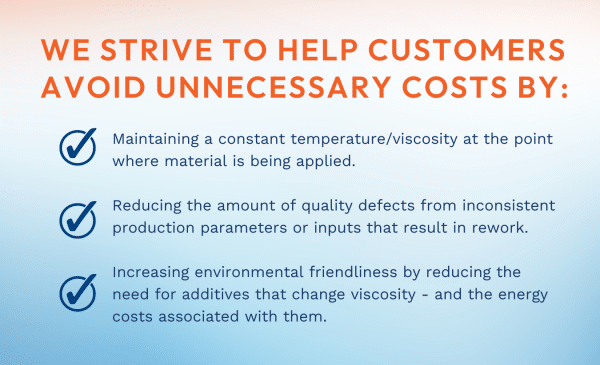A while back, I was working on a project for an automotive company with a paint specification from their top customer. But with the manufacturing process they were using at the facility for painting some of the car parts, they were not able to achieve this specification. They faced losing the business altogether. The building and equipment were old, and management’s mentality was all about cost.
After a series of ROI calculations and demonstrations, the lead engineer, an advocate for Saint Clair Systems (SCS) temperature control, was determined to quantify the value of adding our equipment to their then-current system.
At one of our meetings, he put it simply: “What’s the cost if you don’t?”
That question is important, and its relevance never fades. It always makes me stop and think a little more about what those costs actually are.
In some recent personal endeavors, I’ve become frustrated with what I am actually getting for the money I’m spending. It motivates me to find a better product or better brand, or find a better way to get what I need.
What are the Costs?
If you’re reading this, there’s a good chance you’ve either read (or at least skimmed) some of our other blogs about fluid process temperature control.
If you haven’t, here’s the TL;DR: temperature has a huge impact on viscosity.
While each material has its own characteristics and will show variations if left uncontrolled, temperature is the one variable that is most often overlooked in fluid dispensing systems. Unfortunately, overlooking it can result in unsightly variations and less-than-optimal outcomes.
At the end of the day, it’s all about people’s perception of your brand. And that’s the real cost.

During the manufacturing process, there are many factors that can affect production and, ultimately, the product you’re putting out.
In today’s world, we are so focused on the costs of raw materials and lead times that we forget an incredibly important thing: the cost of not producing a quality product is higher in the long run because we’re passing most of the added costs onto our unhappy consumers.
And the way people feel about a product or service can directly impact their experience of it.
How SCS Mitigates Unnecessary Costs
I don’t expect costs and lead times to come back to normal (if there even is a normal anymore) anytime soon.
Even so, in our business, we strive to help customers avoid unnecessary costs by:
- Maintaining a constant temperature/viscosity at the point where material is being applied.
- Reducing the amount of quality defects from inconsistent production parameters or inputs that result in rework.
- Increasing environmental friendliness by reducing the need for additives that change viscosity - and the energy costs associated with them.
And the list goes on…

With decades of experience across a broad spectrum of applications in multiple industries, SCS can easily ascertain the optimal temperature control method for individual applications and utilize cutting-edge technology to give your process a competitive manufacturing advantage. Our experts are always happy to work with your team until your expectations are met or exceeded. We want to provide a cost-effective solution that integrates seamlessly into your current process or, alternatively, one that is easy to add to a new process.
What You Can Do
Your dispense process is made of variables, which can make it difficult to identify the root cause of unexpected or additional costs.
Reducing costs in manufacturing is important because it results in increased revenue and profitability.
Costs come in different forms, so it’s always worthwhile to understand the kind of expenses that are involved in the manufacturing process and find opportunities to minimize each of them wherever possible.
The goal is to be consistent - morning to night, season to season. If you can start to eliminate variables like temperature change, you can evaluate other parts of your process with a more critical (and helpful) eye. The ability to measure and control viscosity is essential to ensuring consistent quality across different application methods.

